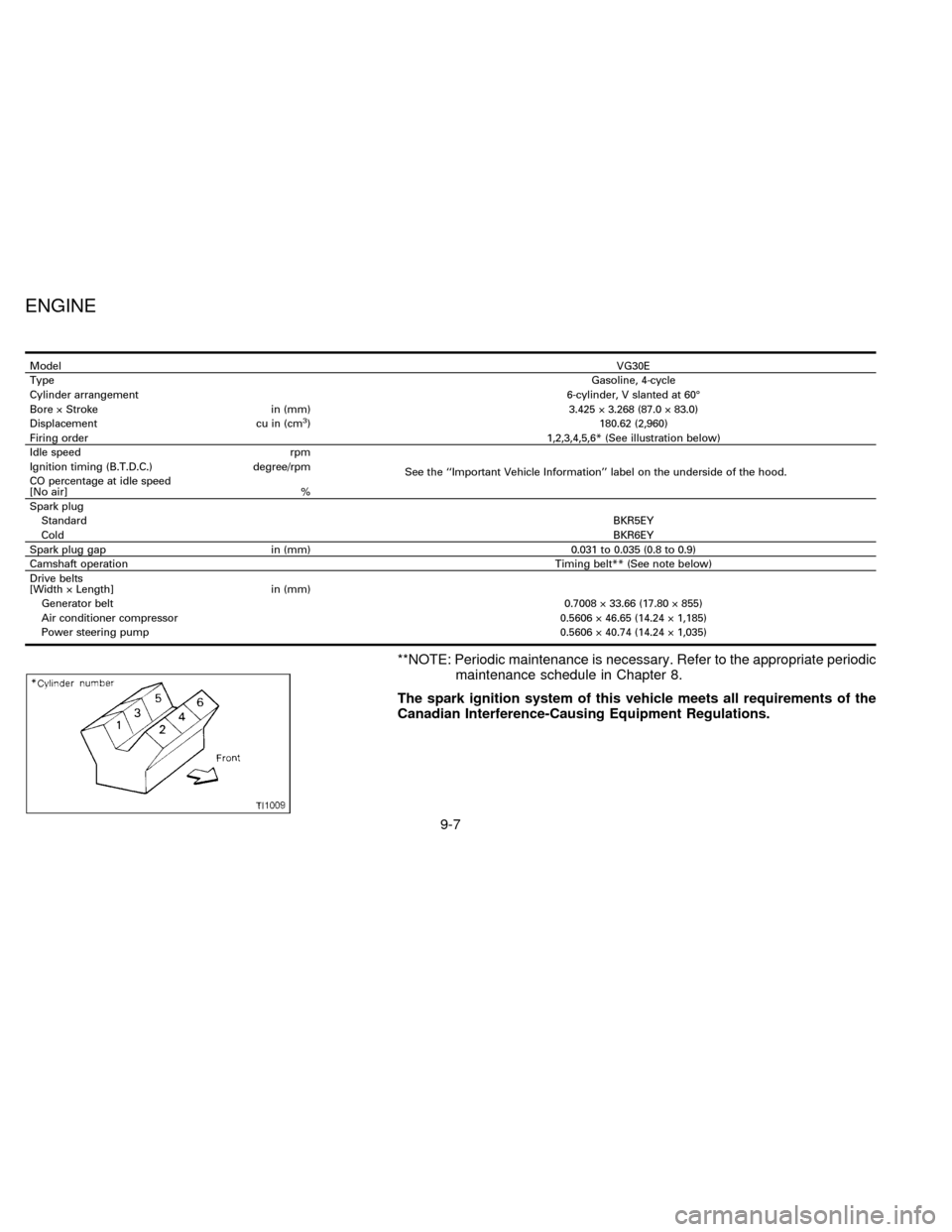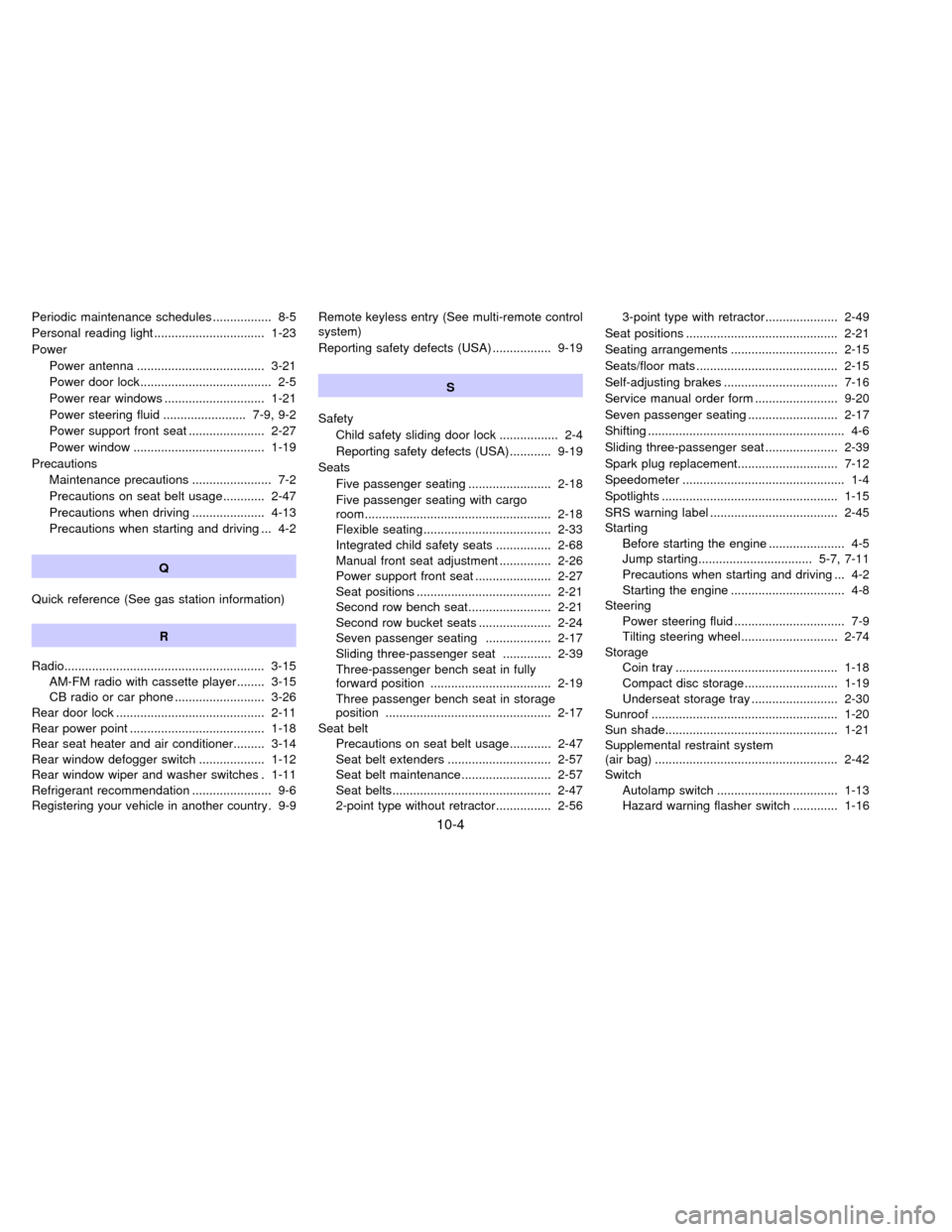1996 NISSAN QUEST Spark
[x] Cancel search: SparkPage 205 of 235
![NISSAN QUEST 1996 V40 / 1.G Owners Manual SCHEDULE 2
Abbreviations: R = Replace I = Inspect. Correct or replace if necessary. [ ]: At the mileage intervals only
MAINTENANCE OPERATIONMAINTENANCE INTERVAL
Perform at number of miles,
kilometers NISSAN QUEST 1996 V40 / 1.G Owners Manual SCHEDULE 2
Abbreviations: R = Replace I = Inspect. Correct or replace if necessary. [ ]: At the mileage intervals only
MAINTENANCE OPERATIONMAINTENANCE INTERVAL
Perform at number of miles,
kilometers](/manual-img/5/598/w960_598-204.png)
SCHEDULE 2
Abbreviations: R = Replace I = Inspect. Correct or replace if necessary. [ ]: At the mileage intervals only
MAINTENANCE OPERATIONMAINTENANCE INTERVAL
Perform at number of miles,
kilometers or months, whichever comes first.Miles ý 1,000 7.5 15 22.5 30 37.5 45 52.5 60
(km ý 1,000) (12) (24) (36) (48) (60) (72) (84) (96)
Months 6 12 18 24 30 36 42 48
Emission control system maintenance
Drive belts See NOTE (1).I*
Air cleaner housing filter[R] [R]
Vapor linesI* I*
Fuel linesI* I*
Fuel filter See NOTE (2)*.
Engine coolant Replace every 30,000 miles (48,000 km) or 36 months.*
Engine oilRRRRRRRR
Engine oil filter (Use Nissan Premium type, or equivalent.) See NOTE (1).RRRRRRRR
Spark plugs[R] [R]
Timing beltReplace every 105,000 miles (168,000 km).
NOTE: (1) After 60,000 miles (96,000 km) or 48 months, inspect every 15,000 miles (24,000 km) or 12 months.
(2) If vehicle is operated under extremely adverse weather conditions or in areas where ambient temperature are either extremely low or
extremely high, the filters might become clogged. In such an event, replace them immediately.
* Maintenance items and intervals with ``*'' are recommended by NISSAN for reliable vehicle operation. The owner need not perform such
maintenance in order to maintain the emission warranty or manufacturer recall liability. Other maintenance items and intervals are
required.
8-8
ZX
Page 207 of 235

EXPLANATION OF
MAINTENANCE ITEMS
Additional information on the following
items with ``*'' is found in the ``Do-it-
yourself operations'' section.
Emission control system mainte-
nance
Drive belts* ÐCheck drive belts for wear,
fraying or cracking and also for proper ten-
sion. Replace the drive belts if found dam-
aged.
Air cleaner filter ÐUnder normal driving
conditions, the air cleaner filter should be
replaced in accordance with the mainte-
nance schedule. However, driving the ve-
hicle in dusty areas may cause more rapid
clogging of the element. Consequently, the
element may have to be replaced more
frequently.
Vapor lines ÐCheck vapor lines and con-
nections for failure or looseness. If leaks are
found, replace them.
Fuel lines ÐCheck the fuel hoses, piping
and connections for leaks, looseness or
deterioration. Replace any parts if they are
damaged.Fuel filter ÐIf the vehicle is operated
under extremely adverse weather condi-
tions or in areas where ambient tempera-
tures are either extremely low or extremely
high, the filter might become clogged. In
such an event, replace the filter immedi-
ately.
Engine coolant* ÐChanging engine cool-
ant can be performed by your NISSAN
dealer or procedures can be found in the
Service Manual. Improper air relief after
changing coolant can result in reduced
heater performance and overheating.
Engine oil & oil filter* ÐUnder normal
driving conditions, the engine oil and oil filter
should be replaced in accordance with the
maintenance schedule. However, under se-
vere driving conditions, they may have to be
replaced more frequently.
Spark plugs* ÐReplace with new plugs
having the correct heat range.
Timing belt ÐReplace the timing belt for
driving the camshaft.
Chassis and body maintenance
Brake lines & cables ÐCheck the brake
lines and hoses (including brake boostervacuum hoses, connections & check valve)
and parking brake cables for proper attach-
ment, leaks, cracks, chafing, abrasion, de-
terioration, etc.
Brake pads, discs, drums & linings Ð
Check these and the other neighboring
brake components for wear, deterioration
and leaks. Under severe driving conditions,
they may have to be inspected more fre-
quently.
Automatic transmission fluid* ÐCheck
the fluid level and visually inspect for signs
of leakage.
Under severe driving conditions, the fluid
should be replaced at the specified interval.
Steering gear & linkage, axle & suspen-
sion parts, and drive shaft boots Ð
Check for damage, looseness and leakage
of oil or grease. Under severe driving con-
ditions, more frequent inspection should be
performed.
Steering linkage ball joints & front sus-
pension ball joints ÐCheck the ball joints
for damage, looseness and grease leakage.
8-10
ZX
Page 212 of 235

Gasoline containing oxygenates
Some fuel suppliers sell gasoline containing
oxygenates such as ethanol, MTBE and
methanol with or without advertising their
presence. Nissan does not recommend the
use of fuels of which the oxygenate content
and the fuel compatibility for your NISSAN
cannot be readily determined. If in doubt,
ask your service station manager.
If you use oxygenate-blend gasoline, please
take the following precautions as the usage
of such fuels may cause vehicle perfor-
mance problems and/or fuel system dam-
age.
cThe fuel should be unleaded and have
an octane rating no lower than that
recommended for unleaded gasoline.
cIf an oxygenate-blend, excepting a
methanol blend, is used, it should
contain no more than 10% oxygenate.
(MTBE may, however, be added up to
15%.)
cIf a methanol blend is used, it should
contain no more than 5% methanol
(methyl alcohol, wood alcohol). It
should also contain a suitable amount
of appropriate cosolvents and corro-sion inhibitors. If not properly formu-
lated with appropriate cosolvents and
corrosion inhibitors, such methanol
blends may cause fuel system dam-
age and/or vehicle performance prob-
lems. At this time, sufficient data is
not available to ensure that all metha-
nol blends are suitable for use in NIS-
SAN vehicles.
If any undesirable driveability problems
such as engine stalling and difficult hot-
starting are experienced after using
oxygenate-blend fuels, immediately change
to a non-oxygenate fuel or a fuel with a low
blend of MTBE.
Take care not to spill gasoline during
refueling. Gasoline containing oxygen-
ates can cause paint damage.
After market fuel additives
NISSAN does not recommend the use of
any fuel additives (i.e.: fuel injector cleaner,
octane booster, intake valve deposit remov-
ers, etc.) which are sold commercially.
Many of these additives intended for gum,
varnish or deposit removal may contain
active solvents or similar ingredients thatcan be harmful to the fuel system and
engine.
Octane rating tips
In most parts of North America, you should
use unleaded gasoline with an octane rating
of at least 87 AKI (Anti-Knock Index) num-
ber. However, you may use unleaded gaso-
line with an octane rating as low as 85 AKI
(Anti-Knock Index) in high altitude areas
(over 4,000 ft [1,219 m]) such as: Colorado,
Montana, New Mexico, Utah, Wyoming,
northeastern Nevada, southern Idaho,
western South Dakota, western Nebraska,
and that part of Texas which is directly
south of New Mexico.
Using unleaded gasoline with an octane
rating lower than stated above can cause
persistent, heavy ``spark knock.'' (``Spark
knock'' is a metallic rapping noise.) If
severe, this can lead to engine damage. If
you detect a persistent heavy spark
knock even when using gasoline of the
stated octane rating, or if you hear steady
spark knock while holding a steady
speed on level roads, have your dealer
correct the condition. Failure to correct
the condition is misuse of the vehicle, for
which NISSAN is not responsible.
9-3
ZX
Page 213 of 235

Incorrect ignition timing results in knocking,
after-run, and/or overheating. This in turn
may cause excessive fuel consumption or
damage to the engine. If any of the above
symptoms are encountered, have your ve-
hicle checked at a NISSAN dealer or other
competent service facility.
However, now and then you may notice
light spark knock for a short time while
accelerating or driving up hills. This is
no cause for concern, because you get
the greatest fuel benefit when there is
light spark knock for a short time under
heavy engine load.
ENGINE OIL AND OIL FILTER
RECOMMENDATION
Selecting the correct oil
It is essential to chose the correct quality
and viscosity oil to ensure satisfactory en-
gine life and performance. Nissan recom-
mends the use of a low friction oil (energy
conserving oil) in order to improve fuel
economy and conserve energy. Oils which
do not have the specified quality label
should not be used as they could cause
engine damage.Only those engine oils with the American
Petroleum Institute (API) CERTIFICATION
MARK on the front of the container should
be used. This type of oil supersedes the
existing API SG or SH and Energy Conserv-
ing II categories.
If you cannot find engine oil with the CER-
TIFICATION MARK, an API SG or SH and
Energy Conserving II oil with API Service
Symbol may be used. An oil with a single
designation SG or SH, or in combination
with other categories (for example, SG/CC
or SG/CD) may also be used if one with the
ATI0507
9-4
ZX
Page 216 of 235

ModelVG30E
TypeGasoline, 4-cycle
Cylinder arrangement6-cylinder, V slanted at 60É
Bore ý Stroke in (mm) 3.425 ý 3.268 (87.0 ý 83.0)
Displacement cu in (cm
3) 180.62 (2,960)
Firing order1,2,3,4,5,6* (See illustration below)
Idle speed rpm
See the ``Important Vehicle Information'' label on the underside of the hood. Ignition timing (B.T.D.C.) degree/rpm
CO percentage at idle speed
[No air] %
Spark plug
StandardBKR5EY
ColdBKR6EY
Spark plug gap in (mm) 0.031 to 0.035 (0.8 to 0.9)
Camshaft operationTiming belt** (See note below)
Drive belts
[Width ý Length] in (mm)
Generator belt0.7008 ý 33.66 (17.80 ý 855)
Air conditioner compressor0.5606 ý 46.65 (14.24 ý 1,185)
Power steering pump0.5606 ý 40.74 (14.24 ý 1,035)
**NOTE: Periodic maintenance is necessary. Refer to the appropriate periodic
maintenance schedule in Chapter 8.
The spark ignition system of this vehicle meets all requirements of the
Canadian Interference-Causing Equipment Regulations.
ENGINE
9-7
ZX
Page 233 of 235

Periodic maintenance schedules ................. 8-5
Personal reading light ................................ 1-23
Power
Power antenna ..................................... 3-21
Power door lock...................................... 2-5
Power rear windows ............................. 1-21
Power steering fluid ........................ 7-9, 9-2
Power support front seat ...................... 2-27
Power window ...................................... 1-19
Precautions
Maintenance precautions ....................... 7-2
Precautions on seat belt usage............ 2-47
Precautions when driving ..................... 4-13
Precautions when starting and driving ... 4-2
Q
Quick reference (See gas station information)
R
Radio.......................................................... 3-15
AM-FM radio with cassette player ........ 3-15
CB radio or car phone .......................... 3-26
Rear door lock ........................................... 2-11
Rear power point ....................................... 1-18
Rear seat heater and air conditioner......... 3-14
Rear window defogger switch ................... 1-12
Rear window wiper and washer switches . 1-11
Refrigerant recommendation ....................... 9-6
Registering your vehicle in another country. 9-9Remote keyless entry (See multi-remote control
system)
Reporting safety defects (USA) ................. 9-19
S
Safety
Child safety sliding door lock ................. 2-4
Reporting safety defects (USA) ............ 9-19
Seats
Five passenger seating ........................ 2-18
Five passenger seating with cargo
room...................................................... 2-18
Flexible seating..................................... 2-33
Integrated child safety seats ................ 2-68
Manual front seat adjustment ............... 2-26
Power support front seat ...................... 2-27
Seat positions ....................................... 2-21
Second row bench seat........................ 2-21
Second row bucket seats ..................... 2-24
Seven passenger seating ................... 2-17
Sliding three-passenger seat .............. 2-39
Three-passenger bench seat in fully
forward position ................................... 2-19
Three passenger bench seat in storage
position ................................................ 2-17
Seat belt
Precautions on seat belt usage............ 2-47
Seat belt extenders .............................. 2-57
Seat belt maintenance.......................... 2-57
Seat belts.............................................. 2-47
2-point type without retractor................ 2-563-point type with retractor..................... 2-49
Seat positions ............................................ 2-21
Seating arrangements ............................... 2-15
Seats/floor mats ......................................... 2-15
Self-adjusting brakes ................................. 7-16
Service manual order form ........................ 9-20
Seven passenger seating .......................... 2-17
Shifting ......................................................... 4-6
Sliding three-passenger seat ..................... 2-39
Spark plug replacement............................. 7-12
Speedometer ............................................... 1-4
Spotlights ................................................... 1-15
SRS warning label ..................................... 2-45
Starting
Before starting the engine ...................... 4-5
Jump starting................................. 5-7, 7-11
Precautions when starting and driving ... 4-2
Starting the engine ................................. 4-8
Steering
Power steering fluid ................................ 7-9
Tilting steering wheel............................ 2-74
Storage
Coin tray ............................................... 1-18
Compact disc storage........................... 1-19
Underseat storage tray ......................... 2-30
Sunroof ...................................................... 1-20
Sun shade.................................................. 1-21
Supplemental restraint system
(air bag) ..................................................... 2-42
Switch
Autolamp switch ................................... 1-13
Hazard warning flasher switch ............. 1-16
10-4
ZX